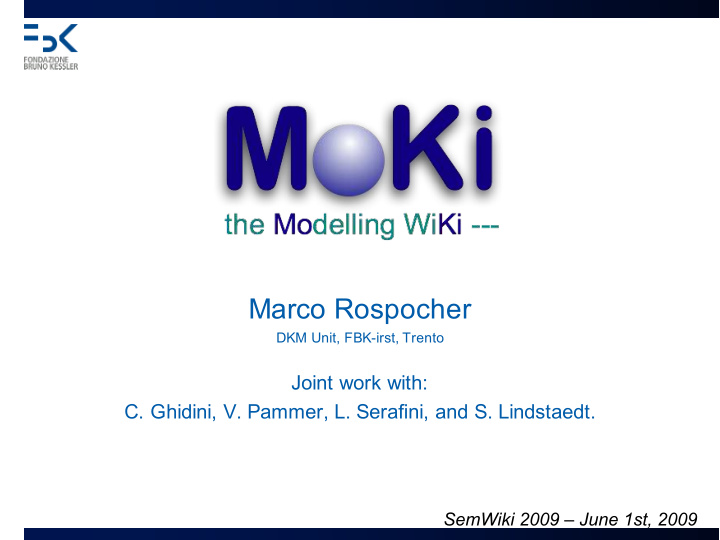



Marco Rospocher DKM Unit, FBK-irst, Trento Joint work with: C. Ghidini, V. Pammer, L. Serafini, and S. Lindstaedt. SemWiki 2009 – June 1st, 2009
Motivations • Enterprise modelling: modelling the relevant aspects of an enterprise. • Enterprise modelling is a collaborative activity involving a team of modellers. • Our collaborative modelling paradigm: – asynchronous collaboration toward the creation of the enterprise model; – specification at different degrees of formality; – automatized alignment between informal/formal specification. 2
MoKi : the Mo delling Wi Ki • It supports our collaborative paradigm. • It currently supports the creation of integrated domain and process models. • It is built on top of Semantic MediaWiki. – wikis support collaborative editing; – users are quite familiar with wikis; – only a web-browser is required on the client side; – wikis can provide a uniform tool/interface for the specification of enterprise model; – semantic information provided in the wiki can be reused to automatically create the formal models.
Pages in Moki • A page for each element of the enterprise model, containing: – an informal description in natural language, to document and clarify the model; – a structured part composed of triples (subject, relation, object), to represent the intra/inter- connection between elements of the models. • Use of appropriate forms/templates to guide users in providing valuable descriptions.
A domain concept page • Similarly for properties and processes.
Import • Import of an available domain ontology. • Input of structured lists of elements. – inserting lists of domain concepts organized according to pre-defined semantic structures (taxonomy or partonomy). • Text analysis functionalities. – extract relevant terms from digital resources, and to cluster such terms according to their relatedness. (KnowMiner)
Visualisation
Process editing
Revision & Export • Revision support: automatic checks to verify the quality of the enterprise model. • Export functionalities: automatic export of the enterprise model to an OWL ontology. – The process model and the domain model can also be exported separately. – The process model can also be exported in a BPMN specification (eRDF serialisation).
Usage of MoKi • Used to create six medium-size enterprise models for the use cases in APOSDLE (FP6 EU-project – www.aposdle.org). • Used in a Knowledge Management course at TU Graz (6 installations with ~50 users each). • In use @ the Joint European Summer School on Technology Enhanced Learning 2009. • Twin tools: – Clip-MoKi – collaborative tool for modeling clinical protocols encoded in ASBRU; – BP-Moki – collaborative tool for the creation of semantically annotated business processes.
Things we are working on… • Support modelling of individuals and data-type properties. • Provide tailored templates for different families of ontology concepts. • Extend import/export functionalities to support more expressive constructs. • Extend support for revision. • Support different levels of formality for differently skilled users.
This is the end… • A demo version of MoKi is available on line at: moki.fbk.eu • For any question/info feel free to contact me at: Marco Rospocher (rospocher@fbk.eu) See you @ the demo!
Recommend
More recommend